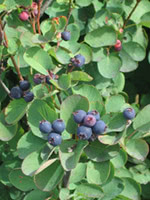Mon-Fri 9am - 5pm Mountain time
Black Elderberry vs Common Saskatoon (Serviceberry)
Sambucus canadensis
Amelanchier alnifolia
NOT AVAILABLE THIS SEASON - MIGHT RETURN
NOT AVAILABLE THIS SEASON - MIGHT RETURN
Black Elderberry is a deciduous shrub native to eastern North America. You can plant this shrub in moist areas and it will help stabilize your soil. You can also use it on rural properties anywhere you'd use a lilac.
Black Elderberries are considered to be partially self-pollinating. So while they will still produce some berries without cross-pollination, planting with another variety will increase yields. Consider planting with Ranch Elderberry or Bob Gordon Elderberry.
Warning: the seeds, stems, leaves, roots, and uncooked berries of the Black Elderberry are poisonous to humans when eaten in quantity. You should cook the berries to make them safe for human consumption.
Common Saskatoon is a native shrub that's famous for its great-tasting fruit. The berries are terrific for fresh eating and cooking. The Saskatoon bush itself can be quite large and produces an abundance of fruit. Saskatoons are hardy and can tolerate partial shade and a variety of growing conditions.
Black Elderberry Quick Facts
Common Saskatoon (Serviceberry) Quick Facts
Toxicity: leaves, stems, and uncooked berries are poisonous to humans

